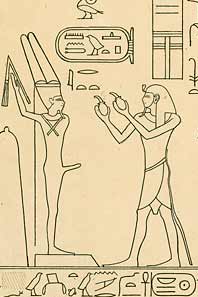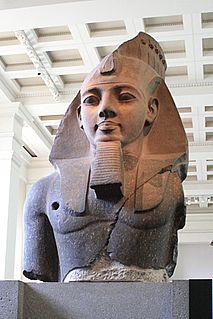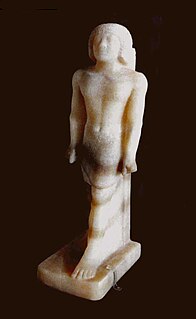The 27th century BC was a century which lasted from the year 2700 BC to 2601 BC.

Saqqara, also spelled Sakkara or Saccara in English, is a vast, ancient burial ground in Egypt, serving as the necropolis for the Ancient Egyptian capital, Memphis. Saqqara features numerous pyramids, including the world-famous Step pyramid of Djoser, sometimes referred to as the Step Tomb due to its rectangular base, as well as a number of mastabas. Located some 30 km (19 mi) south of modern-day Cairo, Saqqara covers an area of around 7 by 1.5 km.

Menkaure, was an ancient Egyptian king (pharaoh) of the 4th dynasty during the Old Kingdom, who is well known under his Hellenized names Mykerinos and Menkheres. According to Manetho, he was the throne successor of king Bikheris, but according to archaeological evidences he rather was the successor of king Khafre. Menkaure became famous for his tomb, the Pyramid of Menkaure, at Giza and his beautiful statue triads, showing the king together with his wives Rekhetre and Khamerernebty.

The Middle Kingdom of Egypt is the period in the history of ancient Egypt following a period of political division known as the First Intermediate Period. The Middle Kingdom lasted from around 2050 BC to around 1710 BC, stretching from the reunification of Egypt under the reign of Mentuhotep II of the Eleventh Dynasty to the end of the Twelfth Dynasty. The Eleventh Dynasty ruled from Thebes and the Twelfth Dynasty ruled from el-Lisht. Some scholars also include the Thirteenth Dynasty of Egypt wholly into this period as well, in which case the Middle Kingdom would finish around 1650, while others only include it until Merneferre Ay around 1700 BC, last king of this dynasty to be attested in both Upper and Lower Egypt. During the Middle Kingdom period, Osiris became the most important deity in popular religion. The Middle Kingdom was followed by the Second Intermediate Period of Egypt, another period of division that involved foreign invasions of the country by the Hyksos of West Asia.

Wahibre Psamtik I, known by the Greeks as Psammeticus or Psammetichus, who ruled 664–610 BC, was the first of three kings of that name of the Saite, or Twenty-sixth Dynasty of Egypt. Historical references for what the Greeks referred to as the Dodecarchy, a loose confederation of twelve Egyptian territories, based on the traditional nomes, and the rise of Psamtik I in power, establishing the Saitic Dynasty, are recorded in Herodotus's Histories, Book II: 151–157. From cuneiform texts, it was discovered that twenty local princelings were appointed by Esarhaddon and confirmed by Ashurbanipal to govern Egypt.

Sahure was an ancient Egyptian pharaoh, the second ruler of the Fifth Dynasty, who reigned for about 12 years in the early 25th century BC. Sahure is considered to be one of the most important kings of the Old Kingdom of Egypt, his reign being a political and cultural high point of the Fifth Dynasty. He was probably the son of his predecessor Userkaf with queen Neferhetepes II, and was in turn succeeded by his son Neferirkare Kakai.

The Valley of the Queens is a site in Egypt, where wives of Pharaohs were buried in ancient times. In ancient times, it was known as Ta-Set-Neferu, meaning –"the place of beauty".

Nebtawyre Mentuhotep IV was the last king of the 11th Dynasty. He seems to fit into a 7-year period in the Turin Canon for which there is no recorded king.

Khaneferre Sobekhotep IV was one of the more powerful Egyptian kings of the 13th Dynasty, who reigned at least eight years. His brothers, Neferhotep I and Sihathor, were his predecessors on the throne, the latter having only ruled as coregent for a few months.
Usermontu was an ancient Egyptian vizier from the reign of Tutankhamun to likely the reign of Horemheb, during the 18th Dynasty.

Ankhu was an Egyptian vizier who lived in the 13th Dynasty around 1750 BC.

The Department of Ancient Egypt and Sudan is a department forming an historic part of the British Museum, housing the world's largest and most comprehensive collection of Egyptian antiquities outside the Egyptian Museum in Cairo.

The Ancient Egyptian Noble Paser was vizier, in the reigns of Seti I and Ramesses II, during the 19th dynasty. He would later also become High Priest of Amun.
The Ancient Egyptian Noble Prehotep I was Vizier, in the latter part of the reign of Ramesses II, during the 19th dynasty.

Babaef was a vizier from the late Fourth dynasty of Egypt. He was likely the son of the vizier Duaenre and hence a grandson of Khafre. He served as vizier during the reign of his cousin Shepseskaf.
The Eighteenth Dynasty of Egypt is classified as the first dynasty of the New Kingdom of Egypt, the era in which ancient Egypt achieved the peak of its power. The Eighteenth Dynasty spanned the period from 1549/1550 to 1292 BC. This dynasty is also known as the Thutmosid Dynasty for the four pharaohs named Thutmose.

The Nineteenth Dynasty of Egypt is classified as the second Dynasty of the Ancient Egyptian New Kingdom period, lasting from 1292 BC to 1189 BC. The 19th Dynasty and the 20th Dynasty furthermore together constitute an era known as the Ramesside period. This Dynasty was founded by Vizier Ramesses I, whom Pharaoh Horemheb chose as his successor to the throne.
Nebweben was an ancient Egyptian vizier of the North under pharaoh Thutmose III of the 18th Dynasty.

Bakenrenef or Bakenranef was an ancient Egyptian Vizier of the North during the reign of Psamtik I of the 26th Dynasty. Like Khaemwaset several centuries before, he bore the title of Iunmutef, “Cleaner of the Great House”. His father was a mayor called Padineit, while his mother was a certain Tageb.

Sasobek was an ancient Egyptian Vizier who officiated between the late 25th – early 26th Dynasty, during the reign of pharaoh Psamtik I. Being the "Vizier of the North", he resided and officiated from Sais, in Lower Egypt.




















